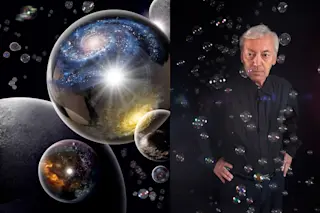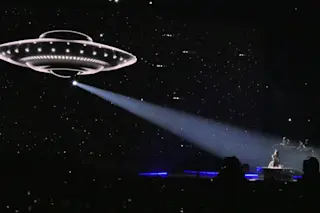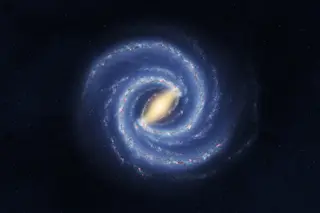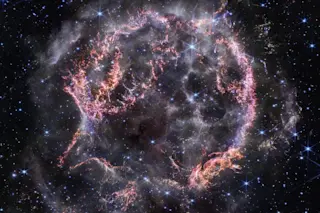It is cosmology’s most fundamental question: How did the universe begin?
The question presupposes that the universe had an actual starting point, but one might just as well assume the universe always was and always will be. In that case, there would be no beginning whatsoever — just an ever-evolving story of which we’re catching a mere glimpse.
“We have very good evidence that there was a Big Bang, so the universe as we know it almost certainly started some 14 billion years ago. But was that the absolute beginning, or was there something before it?” asks Alexander Vilenkin, a cosmologist at Tufts University near Boston. It seems like the kind of question that can never be truly answered because every time someone proposes a solution, someone else can keep asking the annoying question: What happened before that?
But now Vilenkin says he has convincing evidence in hand: The universe had a distinct beginning — though he can’t pinpoint the time. After 35 years of looking backward, he says, he’s found that before our universe there was nothing, nothing at all, not even time itself.
Throughout his career, including the 20-plus years he has directed the Tufts Institute of Cosmology, Vilenkin has issued a series of wild, dazzling ideas, though from the outside he looks neither wild nor dazzling. The 64-year-old professor is soft-spoken, trim and of modest build. He dresses neatly, in neutral, understated tones that don’t draw attention to him.
Despite a low-key manner bordering on subdued, Vilenkin is a creative force who has continually found ways of piercing the fog surrounding some of the densest quandaries imaginable — triumphs that have earned him the respect of scholars worldwide. “Alex is a very original and deep thinker who has made important and profound contributions to our notions about the creation of the universe,” says Stanford cosmologist Andrei Linde.
Yet this brilliant career might never have happened. Born in the Soviet Union in 1949 and raised in the Ukrainian city of Kharkiv, Vilenkin got hooked on cosmology in high school, after reading about the Big Bang in a book by Sir Arthur Eddington. That “obsession” over the universe’s origins, Vilenkin says, “has never left me. I felt that if you could work on this question, which may be the most intriguing one of all, why would you choose to work on anything else?”
As an undergraduate at Kharkiv National University, Vilenkin says he was advised to “do some real physics” rather than pursue his first love, cosmology. Although he was an excellent student, he could not get into any graduate programs in physics because, he suspects, the KGB blacklisted him for refusing to become a government informant. Instead, Vilenkin was forced to take a series of mundane jobs. For a while he taught night school for adults but left that position because his responsibilities included going to the homes of absentees, many of whom were alcoholics, to try and drag them to school — an unenviable task.
He was a night watchman for about a year and a half, including a stint at the Kharkiv Zoo. To protect the animals (which were sometimes hunted for food), he was given a rifle that he didn’t know how to use and fortunately never had to fire. When he had time during those long nights, Vilenkin studied physics, an avocation that included reading the four-volume collected works of Albert Einstein. He got fired from this plum assignment when someone decided — perhaps based on his choice of reading material — that he was overqualified for the task at hand.
With his employment prospects looking bleak, he decided to emigrate to the United States; he figured he’d start out washing dishes while trying to break into academia. But getting out of the Soviet Union required an elaborate plan: Jews like him were allowed to go to Israel in small numbers, determined by a quota, but one had to secure an invitation from Israeli relatives first. Vilenkin had no actual relatives there, so he contacted a friend who knew people in Israel and eventually found someone — a stranger to him — kind enough to write a letter on his behalf.
After the letter arrived, he waited a year for a visa, but it came at great cost. Before Vilenkin and his wife could leave, their parents had to consent to the move. For giving their permission, his wife’s parents lost their laboratory jobs. His father, a university professor, later lost his job, too. The traditional stop en route to Israel was Vienna, but from there Vilenkin, his wife and 1-year-old daughter went to Rome instead, arriving in 1976. They met with the U.S. Consulate in Rome and, after a three-month wait, were finally granted a visa to the U.S.
Back to the Big Bang
In fall 1977, Vilenkin took a postdoctoral position at Case Western Reserve, where he was supposed to study the electrical properties of heated metals. Still, he found time on the side to theorize about spinning black holes and their mysterious magnetic fields. A year later, he got his lucky break when Tufts offered him a one-year visiting position. He took a gamble by poring himself into cosmology, an area considered fringe at the time.
That would soon change. In late 1979, a Stanford physics postdoc named Alan Guth offered an explanation for the explosive force behind the Big Bang. Guth’s intellectual leap stemmed from theories in particle physics, which held that at extremely high energies — far higher than could ever be reached in a laboratory — a special state of matter would turn gravity upside down, rendering it a repulsiverather than an attractive force.
A patch of space containing a tiny bit of this unusual matter could repel itself so violently as to literally blow up. Guth suggested that a tremendous burst of this sort triggered the Big Bang, swiftly enlarging the universe so much it doubled in size at least 100 times. This exponential growth spurt — called cosmic inflation — was short-lived, however, lasting just a tiny fraction of a second because the repulsive material quickly decayed, leaving behind the more familiar forms of matter and energy that fill the universe today.
The idea simultaneously solved a number of puzzles in cosmology. It explained where the “bang” behind the Big Bang came from and how the cosmos got so big. Rapid inflation in every direction also explained why the universe we now observe is so homogeneous, and why the temperature of the background radiation left over from that primordial blast is uniform, in every patch of the sky, to one part in 100,000. Inflation also revitalized cosmology, giving theorists like Vilenkin plenty to think about — and a bit more respectability to boot.
The Never-Ending Story
By 1982, a couple of years after Guth’s breakthrough, Vilenkin had a realization of his own: The process of inflation had to be eternal, meaning that once it started, it never fully stopped. Inflation might end abruptly in one region of space, such as the one we inhabit, but it would continue elsewhere, setting off a never-ending series of big bangs. Each bang would correspond to the birth of a separate “pocket” universe, which might be pictured as an expanding bubble — one of countless bubbles floating around within the “multiverse,” as it’s sometimes called.
As Vilenkin saw it, inflation’s eternal nature stemmed from two competing properties of the cosmic fuel, the gravity-repulsive material that caused the universe to rapidly expand. On the one hand, the material was unstable, much like radioactive substances, and was thus doomed to decay. On the other hand, the material expanded far faster than it decayed, so even though decay might stop inflation in certain regions, runaway growth would continue in others.

(Credit: Roen Kelly/Discover)
Roen Kelly/Discover
As an analogy, Vilenkin suggests a blob of bacteria that wants to keep reproducing and growing, while bacteria-killing antibodies try to curtail that growth. If the bacteria reproduce much faster than they’re destroyed, they will swiftly multiply and spread even though their reproduction may be thwarted in some quarters. Either way you look at it, the net result is that inflation (or bacterial growth) never ends everywhere at once and is always going on in some portion of the multiverse — even as you read this magazine.
To gain a better sense of the phenomenon, Vilenkin teamed up in 1986 with a Tufts graduate student, Mukunda Aryal, on a computer simulation that showed what an eternally inflating universe might look like. In their simulation, inflating regions, or bubbles, started small and steadily grew, while the space between bubbles stretched out as well. Each bubble — representing a mini-universe like ours — was surrounded by smaller bubbles, which were themselves surrounded by even smaller bubble universes, in turn.
Road to Eternity
In Vilenkin’s bubbling universe, inflation was, by definition, eternal into the future. Once initiated, it would not stop. But was it also eternal into the past? Was there ever a time when the universe was not inflating? And if the universe were always inflating, and always expanding, would that imply that the universe itself was eternal and had no beginning?
To address this question, Vilenkin joined forces with Guth and Long Island University mathematician Arvind Borde. Using a mathematical proof, they argued that any expanding universe like ours had to have a beginning. The thought experiment they posed went like this: Imagine a universe filled with particles. As it steadily expands, the distance between particles grows. It follows that observers sprinkled throughout this expanding universe would be moving away from each other until, eventually, they occupied widely scattered regions of space. If you happened to be one of those observers, the farther an object was from you, the faster it would be moving away.
Now throw into the mix a space traveler moving through space at a fixed speed: He zooms past Earth at 100,000 kilometers per second. But when he reaches the next galaxy, which is moving away from us at, say, 20,000 kilometers per second, he will appear to be moving only 80,000 kilometers per second to observers there. As he continues on his outward journey, the space traveler’s speed will appear smaller and smaller to the observers he passes. Now we’ll run the movie backward. This time, the space traveler’s velocity will appear faster and faster at each successive galaxy.
If we assume inflation is eternal into the past — that it had no beginning — the space traveler will eventually reach and overtake the speed of light. A calculation by Borde, Guth and Vilenkin showed that this would happen in a finite amount of time. But according to the laws of relativity, it is impossible for any massive object to reach the speed of light, let alone exceed it. “This cannot happen,” says Vilenkin. “So when you follow this space traveler’s history back in time, you find that his history must come to an end.”
The fact that the traveler’s journey backward in time hits an impasse means that there’s a problem, from a logical standpoint, with the assumption of an ever-expanding universe upon which this whole scenario is based. The universe, in other words, could not always have been expanding. Its expansion must have had a beginning, and inflation — a particularly explosive form of cosmic expansion — must have had a beginning, too. By this logic, our universe also had a beginning since it was spawned by an inflationary process that is eternal into the future but not the past.
Something From Nothing
A universe with a beginning begs the vexing question: Just how did it begin? Vilenkin’s answer is by no means confirmed, and perhaps never can be, but it’s still the best solution he’s heard so far: Maybe our fantastic, glorious universe spontaneously arose from nothing at all. This heretical statement clashes with common sense, which admittedly fails us when talking about the birth of the universe, an event thought to occur at unfathomably high energies. It also flies in the face of the Roman philosopher Lucretius, who argued more than 2,000 years ago that “nothing can be created from nothing.”
Of course, Lucretius had never heard of quantum mechanics and inflationary cosmology, 20th-century fields that contest his bold claim. “We usually say that nothing can be created out of nothing because we think it would violate the law of conservation of energy,” a hallowed principle in physics holding that energy can neither be created nor destroyed, Vilenkin explains. So how could you create a universe with matter in it, where there had been nothing before?
“The way the universe gets around that problem is that gravitational energy is negative,” Vilenkin says. That’s a consequence of the fact, mathematically proven, that the energy of a closed universe is zero: The energy of matter is positive, the energy of gravitation is negative, and they always add up to zero. “Therefore, creating a closed universe out of nothing does not violate any conservation laws.”
Vilenkin’s calculations show that a universe created from nothing is likely to be tiny, indeed — far, far smaller than, say, a proton. Should this minute realm contain just a smattering of repulsive-gravity material, that’s enough to ensure it will ignite the unstoppable process of eternal inflation, leading to the universe we inhabit today. If the theory holds, we owe our existence to the humblest of origins: nothing itself.
One virtue of this picture, if correct, is that the spontaneous creation of our universe gives a definite starting point to things. Time begins at the moment of creation, putting to rest the potentially endless questions about “what happened before that.”
Yet the explanation still leaves a huge mystery unaddressed. Although a universe, in Vilenkin’s scheme, can come from nothing in the sense of there being no space, time or matter, something is in place beforehand — namely the laws of physics. Those laws govern the something-from-nothing moment of creation that gives rise to our universe, and they also govern eternal inflation, which takes over in the first nanosecond of time.
That raises some uncomfortable questions: Where did the laws of physics reside before there was a universe to which they could be applied? Do they exist independently of space or time? “It’s a great mystery as to where the laws of physics came from. We don’t even know how to approach it,” Vilenkin admits. “But before inflation came along, we didn’t even know how to approach the questions that inflation later solved. So who knows, maybe we’ll pass this barrier as well.”
In the Clint Eastwood movie Magnum Force, Harry Callahan says, “A man’s got to know his limitations,” but Vilenkin’s work is a testament to pushing past traditional limits. If we persevere in the face of skepticism and doubt, as Vilenkin is often inclined to do, interesting and unexpected ideas may well emerge — just like a universe popping out of nowhere.
Eliminating the Loopholes
Loophole #1
To bolster his hypothesis, Vilenkin has studied other model universes, eliminating loopholes that contradict the idea of a clear-cut cosmic debut. In a 2012 paper with Tufts graduate student Audrey Mithani, Vilenkin examined the “cyclic” universe investigated by physicists Paul Steinhardt of Princeton University and Neil Turok, now at the Perimeter Institute.
In this model, there is neither a single Big Bang nor a single beginning. Instead, the universe continually goes through oscillating cycles of expansion, contraction, collapse and expansion anew. The catch is that the cyclic universe runs into the second law of thermodynamics, which says the entropy, or disorder, of a closed system will inevitably increase over time.

Classic Cyclic Universe (Credit: Roen Kelly/Discover)
Roen Kelly/Discover
For example, an ornate brick mansion is highly ordered, whereas a pile of bricks strewn across the ground — the result of the ravages of nature and decades or centuries of neglect — is more disordered. And brick dust, scattered by wind and water after the bricks themselves have deteriorated, is even more disordered. Left on its own, a system — even a bubble universe — will naturally go this way. We don’t often see a brick mansion spontaneously reassembling itself from dispersed dust.
If our universe has been here forever and maintained a stable size, it, too, would have succumbed to the second law. Disorder would have inexorably increased to the point that the universe would now be a smoothed-out, featureless blur. But that’s not what we see at all. Instead, we see a universe filled with grand cosmic structures — galaxies, clusters of galaxies, clusters of clusters called superclusters, and clusters of superclusters called galaxy filaments — some of the latter stretching a billion or more light-years across.
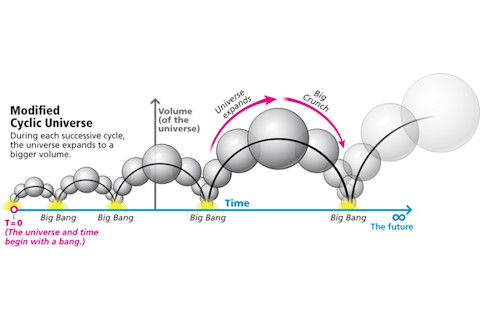
Modified Cyclic Universe (Credit: Roen Kelly/Discover)
Roen Kelly/Discover
For that reason, Vilenkin rules out the cyclic universe picture unless one makes the added assumption that after each cycle of expansion and contraction, the universe ends up somewhat bigger than when it started. The stipulation would leave us with another expanding universe, meaning that the original Borde-Guth-Vilenkin theorem would still apply: An ever-expanding universe must have a single beginning.
Loophole #2
Another possible loophole is the “cosmic egg” scenario, a model universe advanced by South African cosmologist George Ellis, among others. According to this view, the universe can sit forever in a stable configuration, with a fixed size and radius, until it suddenly starts to expand — like an egg hatching after an exceptionally long incubation phase.
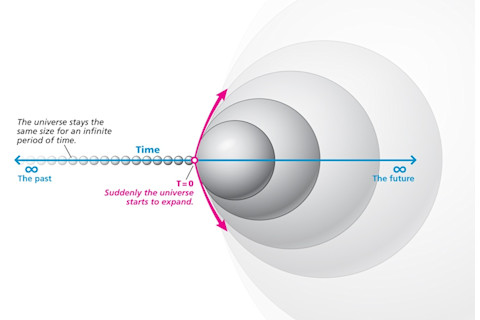
Cosmic Egg Theory. (Credit: Roen Kelly/Discover)
Roen Kelly/Discover
The trouble with this proposition, according to Vilenkin and Mithani, is that the small “stable” universe is not so stable after all. Sometime during the long waiting phase it would collapse to nothingness, before it ever reached the expansionist period — that is, if the laws of quantum mechanics are to be believed.
Quantum mechanics, the prevailing branch of physics for describing how things work on atomic scales, is exquisitely well-tested, and exquisitely weird. Quantum mechanics holds that if there is even the tiniest chance of something happening, however absurd it may sound, that thing is sure to happen if you wait long enough.
As it turns out, quantum mechanical formulas predict a slim (but nonzero) chance of the cosmic egg universe collapsing to zero size, at which point the erstwhile universe would completely disappear. Given an infinite time span, which is what the cosmic egg scenario calls for, such a collapse would be unavoidable — even though the odds of it occurring at any one time are small — implying that the universe could not have existed forever.
Indeed, says Vilenkin, among all the ideas we’ve thought of so far for a universe without a beginning, none of them seem to work. “So the answer to the question of whether the universe had a beginning is yes, it probably did.”
This article originally appeared in print as "Starting Point."


